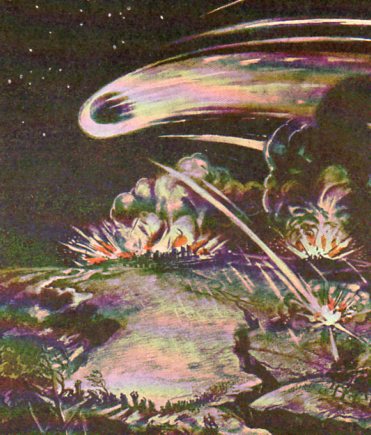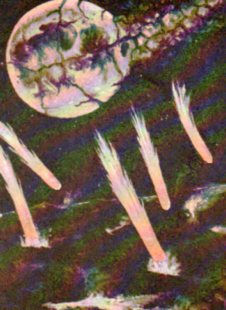JF Ptak Science Books Post 1767
In a post last week in the Strange Things in the Sky department: the Exploding Moon, I mentioned that images of the Earth's Moon actually exploding seem to be quite uncommon. The ever-observant Ray Girvan wrote to say that the Moon does just that in the 2002 remake of H.G. Wells' The Time Machine, when Earth's lunar mining operations disrupt it so that it makes the Moon disintegrate, raining parts of itself on Earth.

And it just so happens that I stumbled on another odd image of the Moon coming to its end: a mention of a drawing by Thomas Voter, showing the Moon disintegrating under the force of the Earth's gravity. It appears in the November, 1939 issue of Popular Mechanics in the "Explorers of Space" article.

And then, on the next page of the magazine appears another image of the breaking Moon by Wallace Favereau, this also showing bits of the Moon slamming into the Earth.

Thomas Voter's illustrations led me to his image showing Boy Scouts flying on their odd destiny to the Moon for a rendezvous with Post-War Moon Nazis in what is a surprising juvie novel by Robert Heinlein, Rocket Ship Galileo (1947). [Image courtesy of the excellent Roborant site, well worth a visit and bookmark, here.] The three boy-rocket-experimenters are on their way their with their Nobelist uncle, piloting a thorium-fueled mail rocket that the Manhattan Project Uncle was able to rig up for interplanetary adventures, which gets them to a nuke-war-ravaged-Moon with victorious commanding Nazis over whom the intrepid travelers eventually triumph. This really has nothing to do with exploding or disintegrating Moons, but finding a reference to Moon Nazis does classify as a strange-thing-in-the-sky. evidently the story is much disparaged by modern readers, though the author of Roborant feels as though there is a much greater depth to the story that the possible high-comic storyline implies.

It looks like there is a sub-genre for Evil Alien Space Nazis in books and film, but I just can't go any further with the topic.


Comments